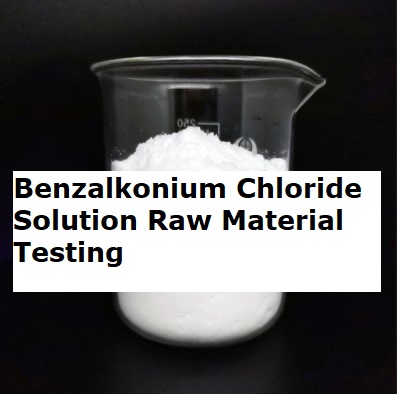
BENZALKONIUM CHLORIDE SOLUTION STANDARD ANALYTICAL PROCEDURE (SAP) OF RAW MATERIAL. Benzalkonium chloride (BKC), a typical quaternary ammonium salt, is often used as an antiseptic.
| AMENDMENT STATUS | |||||
| Sr.# | Date of Amendment | Issue Status | Page No | Page Status | Details of change / review |
| 1 | |||||
| 2 | |||||
| Written by | Checked by | Approved by | Authorized by |
|
Analyst |
Quality Control Manager |
Quality Assurance Manager |
General Manager Plant |
| Date: | Date: | Date: | Date: |
1.0 Purpose
1.1 To ensure the quality of incoming raw material of Benzalkonium Chloride Solution.
2.0 Scope
2.1 It is applicable for the analysis of Benzalkonium Chloride Solution in the quality control
department.
3.0 Responsibility
3.1 Quality Control Manager
3.2 Assist. Q.C. Manager
3.3 Q.C Analyst
4.0 Abbreviations
4.1 SAP: Standard Analytical Procedure
4.2 QC: Quality control
5.0 Procedure
5.1 Equipment’s/Apparatus
a) Glass wares
b) Ice bath
c) Thermometer
d) Analytical Balance
e) Water bath
5.2 Chemicals / Reagents
Chemicals
- Distilled Water
- Alcohol
- Chloroform
Reagents
- Sodium hydroxide (VS) 0.1 N
- Phenolphthalein solution
- Potassium iodide solution
- Bromocresol Purple solution R
- 0.05M potassium iodate 0.05M VS
- Bromophenol Blue Solution R1
- Dilute Sodium Hydroxide Solution
- Dilute Nitric Acid Solution
- 50g/L potassium iodide Solution
- 0.05M Potassium Iodate
5.3 Physical Analysis
a) Test of Colour:
A clear, colourless or slightly yellowish liquid
b) Test of solubility:
Miscible with water and with alcohol. It froths copiously when shaken.
c) Test of Alkalinity or Acidity:
Solution S
Dilute 2.0 g to 100 ml with carbon dioxide-free water (solution S)
To 50 ml of solution S add 0.1 ml of bromocresol purple solution R. Not more than 0.1 ml of 0.1M hydrochloric acid or 0.1M sodium hydroxide is required to change the colour of the indicator.
Appearance of solution:
Solution S is clear and not more intensely coloured than reference solution Y6.
5.4 Chemical Analysis
Identification
a) Dilute 0.3 ml to 100 ml with water R. Examined between 220 nm and 350 nm, the solution shows three absorption maxima, at 257 nm, 263 nm and 269 nm, and a shoulder at about 250 nm.
b) To 5 ml of dilute sodium hydroxide solution R add 0.1 ml of bromophenol blue solution R1 and 5 ml of chloroform R and shake. The chloroform layer is colourless. Add 0.05 ml of the solution to be examined and shake. The chloroform layer becomes blue.
c) To 0.05 ml add 1 ml of dilute nitric acid R. A white precipitate is formed which dissolves on the addition of 5 ml of alcohol R. The solution gives reaction of chlorides.
Assay
Determine the density of the solution to be examined. Dilute 4.00 g to 100.0 ml with water R. Transfer 25.0 ml of the solution to a separating funnel, add 25 ml of chloroform R, 10 ml of 0.1M sodium hydroxide and 10.0 ml of a freshly prepared 50 g/l solution of potassium iodide R. Shake well, allow separating and discarding the chloroform layer. Shake the aqueous layer with three quantities, each of 10 ml, of chloroform R and discard the chloroform layers. To the aqueous layer add 40 ml of hydrochloric acid R, allow cooling and titrating with 0.05M potassium iodate until the deep-brown colour is almost discharged. Add 2 ml of chloroform R and continue the titration, shaking vigorously, until the chloroform layer no longer changes colour. Carry out a blank titration on a mixture of 10.0 ml of the freshly prepared 50 g/l solution of potassium iodide R, 20 ml of water R and 40 ml of hydrochloric acid R.
1 ml of 0.05M potassium iodate is equivalent to 35.4 mg of C22H40ClN.
The limit of solution is 475g/L to 525g/L.
6.0 Quality Record(s)/Form(s):
6.1 The following Quality Records shall be generated and managed in accordance with the Procedure for Control of Company Quality Records.
7.0 Reference:
BP 2020

